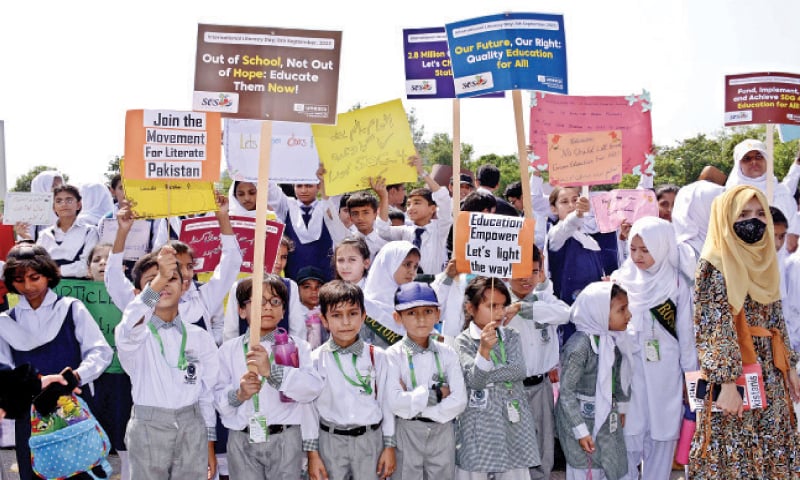By: Saima Sammar
World Literacy Day, observed every year on September 8, underscores the global importance of literacy as a fundamental human right. Since its inception by UNESCO in 1967, the day has served as a reminder of the critical role literacy plays in individual and societal development. In Pakistan, where the literacy rate remains a significant concern, this day offers an opportunity to evaluate the nation’s progress, confront ongoing challenges, and set future goals for an educated society.
Despite its rich cultural heritage and a diverse population, Pakistan continues to grapple with low literacy rates. Over the past few decades, there have been improvements, yet the nation still faces significant hurdles in terms of access to education, gender inequality, and regional disparities. Pakistan’s literacy rate is currently around 60%, making it one of the lowest in South Asia. Provincial differences are stark—Punjab leads with a literacy rate of approximately 64%, while Balochistan lags behind with less than 40%.
These discrepancies are reflective of more profound socio-economic and political factors. The barriers to literacy in Pakistan include poverty, gender inequality, political instability, and poor infrastructure, all of which have hampered efforts to achieve universal education. One of the most significant challenges is the gender gap. Female literacy rates, while improving, still trail behind those of males. In rural areas, the situation is particularly dire, with female literacy rates hovering around 30%, compared to nearly 60% for males. This disparity is fueled by cultural and socio-economic factors, where traditional norms often prioritize boys’ education, leaving girls to face limitations due to early marriages, domestic responsibilities, and safety concerns.
Moreover, regional disparities compound the problem. While urban centers like Islamabad and Karachi boast relatively high literacy rates, provinces like Balochistan and rural Sindh suffer from inadequate infrastructure, poorly trained teachers, and a lack of political attention. In conflict-ridden areas, such as parts of Khyber Pakhtunkhwa, decades of violence have destroyed schools and disrupted the education system, further stunting literacy efforts.
The quality of education is another concern. Although school enrollment has increased, many students, particularly in rural areas, do not acquire basic literacy skills due to outdated curricula, overcrowded classrooms, and underqualified teachers. The lack of investment in modern educational tools and technologies further complicates efforts to provide a quality education, particularly in science, technology, and mathematics.
Economic barriers also play a pivotal role in the literacy crisis. For many families, education remains unaffordable, with children often required to work to support the household. Even when education is ostensibly free, associated costs such as uniforms, books, and transportation can be prohibitive for low-income families, forcing education to take a back seat to economic survival.
Compounding these issues is Pakistan’s political instability, which has contributed to inconsistent education policies. Despite various reforms and pledges to increase education spending, many initiatives have faltered due to corruption, mismanagement, and shifting political priorities. While the government has committed to raising the education budget to the UNESCO-recommended 4-6% of GDP, it has historically remained around 2-3%, significantly hampering literacy efforts.
However, there are signs of progress. Pakistan has made strides in improving literacy through a series of reforms and policies. The government’s “Vision 2025” plan identifies education as a cornerstone of national development, with a focus on improving literacy rates. The Right to Education (RTE) Act, which mandates free and compulsory education for children aged 5 to 16, is another step in the right direction. Provincial governments have also taken action, with Punjab’s School Reforms Roadmap and Khyber Pakhtunkhwa’s investment in teacher training and school infrastructure yielding promising results.
In addition to government efforts, non-governmental organizations (NGOs) and civil society have played a crucial role in bridging the literacy gap. Organizations such as The Citizens Foundation (TCF) and Idara-e-Taleem-o-Aagahi (ITA) have focused on providing quality education to marginalized communities, particularly in rural and underserved areas. Their initiatives complement government efforts by establishing low-cost schools and providing scholarships to students who would otherwise be denied access to education.
Technology has also emerged as a powerful tool in addressing literacy challenges in Pakistan. Digital learning platforms and mobile apps have enabled students in remote areas to access educational resources. Programs like TeleSchool, launched during the COVID-19 pandemic, have helped students continue their education during school closures. While the digital divide remains a challenge, expanding access to technology and integrating it into the education system will be essential for improving literacy in the years to come.
World Literacy Day serves as an annual reminder of the work that remains in Pakistan’s struggle for universal literacy. On this day, educators, government officials, and civil society come together to reflect on progress and discuss strategies for closing literacy gaps. Awareness campaigns, discussions, and events promote the importance of education and encourage communities to prioritize schooling for all children, regardless of gender or socio-economic background.
Looking ahead, there are several key areas where Pakistan must focus its efforts. Increasing education spending is paramount. The government must prioritize education by allocating a minimum of 4-6% of GDP to the sector. This funding should be used to build more schools, improve teacher training, and provide the necessary learning materials. Special initiatives are also needed to address gender inequality, particularly in rural areas. Scholarships, improved school safety, and raising awareness about the value of girls’ education can help bridge the gender gap.
Expanding access to technology will also be critical in improving literacy. Efforts to develop and distribute digital learning platforms and low-cost devices should be prioritized, particularly in rural areas. Furthermore, investing in teacher training programs and strengthening public-private partnerships between the government, NGOs, and the private sector will be essential in addressing the literacy crisis.
By taking these steps and continuing to evaluate and refine its strategies, Pakistan can make significant strides toward achieving universal literacy and building a more educated and empowered society.


